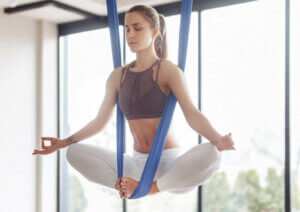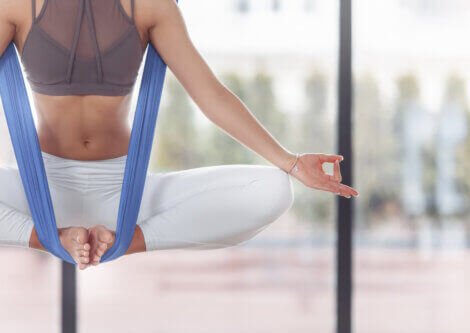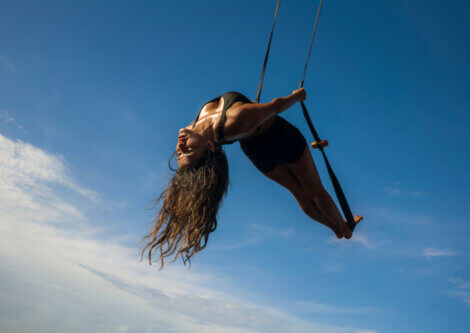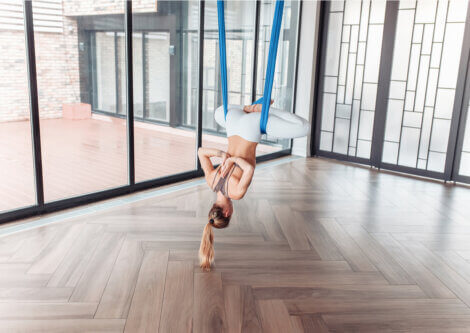What Poses Are Performed in Aerial Yoga?

Aerial yoga is also known as anti-gravity yoga and is currently one of the most trendy forms of yoga. Aerial yoga involves ‘hanging’ from a type of silk swing and doing different acrobatic poses.
Before starting, many people want to know what poses you’ll do and if they’re very difficult. It depends on each person, but it does require a certain amount of commitment to reach the goals and be able to do the different poses in this form of yoga.
What is aerial yoga?
Aerial yoga or Aeroyoga is one of the many different forms of yoga. It’s based on using a swing or hammock, generally of silk or another cloth, to perform different asanas (body postures) while you’re suspended or partially suspended in the air.
By using the swing, you don’t depend on support from the floor. That is, during most of the poses you’re not in contact with any other surface apart from the fabric. This kind of yoga is very attractive due to its novelty and the challenge. However, it’s not new; in Ancient India the ascetics practiced hanging silks from trees to perform different postures for longer.
Aerial yoga is very creative and can help you to perform different poses that are more difficult in traditional yoga. There are two different styles, depending on the swing you use: one style is focussed on technique, and the other on the aesthetic side.
In the first kind of aerial yoga, the swing has three parts: two arms and the main body. The second class has a hammock of just one single piece. Both styles are quite intense, but the second is more visual.
It’s also good to know what the main benefits of yoga are. In that regard, a publication from MSD Manuals shows the benefits of physical exercise in general. We can of course include yoga here. The publication notes the following:
- Increases your flexibility and strength.
- Improves your joints’ range of movement.
- Blood flow and lymphatic drainage activation.
- Increases your self-esteem and mood.
- Provides relief from depression and anxiety.
- Reduces back pain.

What poses can you do in aerial yoga?
We’ve already taken a look at the characteristics and benefits of aerial yoga. Now let’s take a moment to analyze some of the main poses you can do in aerial yoga. These will probably be done in your first class.
1. Seated forward bend pose
Its name in Sanskrit is Vaihayasa Paschimottanasana. To do it, you must be seated on the swing with your feet just touching the floor. Inhale and stretch your arms upwards. Exhale and reach for your toes.
2. Aerial fish pose
It probably sounds hilarious to think of an aerial fish. But really, with this pose, Vaihayasa Matsyasana, what you do is copy a fish as if you were in the water. Stand in the hammock and lean back with your body parallel to the floor, and let your head gently fall back. Your back gets a thorough stretching. Then, look backward as far as you can.

3. Sun salutation pose
Vaihayasa Surya Namaskara is the name of this pose. To do it, support your back with the hammock under your arms and with your feet on the ground, and lean back until your body is straight with your arms stretched out.
The muscles you activate with this aerial yoga pose are your core muscles. Keeping your gaze fixed towards the sky helps to relax your neck muscles.
4. Bound angle pose
This is one of the most complicated poses in aerial yoga because you have to turn upside down. Start the Vaihayasa Baddha Konasana sitting on the swing, then grasp the fabric of the swing about waist height.
Then, gradually lower your upper body back while you raise your hips, spread your legs, and bend your knees.

To finish an aerial yoga class, the last pose is the Savasana, which definitely takes on new meaning if you perform it in the air. Sitting in the hammock, you open the fabric and wrap it right around you, as if you were in a cocoon.
Gradually, you’ll stop swinging and you’ll just be hanging there; as if you were floating. It’s a very relaxing way to finish this kind of physical exercise that’s so unique.
Aerial yoga is also known as anti-gravity yoga and is currently one of the most trendy forms of yoga. Aerial yoga involves ‘hanging’ from a type of silk swing and doing different acrobatic poses.
Before starting, many people want to know what poses you’ll do and if they’re very difficult. It depends on each person, but it does require a certain amount of commitment to reach the goals and be able to do the different poses in this form of yoga.
What is aerial yoga?
Aerial yoga or Aeroyoga is one of the many different forms of yoga. It’s based on using a swing or hammock, generally of silk or another cloth, to perform different asanas (body postures) while you’re suspended or partially suspended in the air.
By using the swing, you don’t depend on support from the floor. That is, during most of the poses you’re not in contact with any other surface apart from the fabric. This kind of yoga is very attractive due to its novelty and the challenge. However, it’s not new; in Ancient India the ascetics practiced hanging silks from trees to perform different postures for longer.
Aerial yoga is very creative and can help you to perform different poses that are more difficult in traditional yoga. There are two different styles, depending on the swing you use: one style is focussed on technique, and the other on the aesthetic side.
In the first kind of aerial yoga, the swing has three parts: two arms and the main body. The second class has a hammock of just one single piece. Both styles are quite intense, but the second is more visual.
It’s also good to know what the main benefits of yoga are. In that regard, a publication from MSD Manuals shows the benefits of physical exercise in general. We can of course include yoga here. The publication notes the following:
- Increases your flexibility and strength.
- Improves your joints’ range of movement.
- Blood flow and lymphatic drainage activation.
- Increases your self-esteem and mood.
- Provides relief from depression and anxiety.
- Reduces back pain.

What poses can you do in aerial yoga?
We’ve already taken a look at the characteristics and benefits of aerial yoga. Now let’s take a moment to analyze some of the main poses you can do in aerial yoga. These will probably be done in your first class.
1. Seated forward bend pose
Its name in Sanskrit is Vaihayasa Paschimottanasana. To do it, you must be seated on the swing with your feet just touching the floor. Inhale and stretch your arms upwards. Exhale and reach for your toes.
2. Aerial fish pose
It probably sounds hilarious to think of an aerial fish. But really, with this pose, Vaihayasa Matsyasana, what you do is copy a fish as if you were in the water. Stand in the hammock and lean back with your body parallel to the floor, and let your head gently fall back. Your back gets a thorough stretching. Then, look backward as far as you can.

3. Sun salutation pose
Vaihayasa Surya Namaskara is the name of this pose. To do it, support your back with the hammock under your arms and with your feet on the ground, and lean back until your body is straight with your arms stretched out.
The muscles you activate with this aerial yoga pose are your core muscles. Keeping your gaze fixed towards the sky helps to relax your neck muscles.
4. Bound angle pose
This is one of the most complicated poses in aerial yoga because you have to turn upside down. Start the Vaihayasa Baddha Konasana sitting on the swing, then grasp the fabric of the swing about waist height.
Then, gradually lower your upper body back while you raise your hips, spread your legs, and bend your knees.

To finish an aerial yoga class, the last pose is the Savasana, which definitely takes on new meaning if you perform it in the air. Sitting in the hammock, you open the fabric and wrap it right around you, as if you were in a cocoon.
Gradually, you’ll stop swinging and you’ll just be hanging there; as if you were floating. It’s a very relaxing way to finish this kind of physical exercise that’s so unique.
All cited sources were thoroughly reviewed by our team to ensure their quality, reliability, currency, and validity. The bibliography of this article was considered reliable and of academic or scientific accuracy.
- Brian D. Johnston. 2018. Beneficios del ejercicio. Manual MSD. https://www.merckmanuals.com/es-us/hogar/fundamentos/ejercicio-y-forma-f%C3%ADsica/beneficios-del-ejercicio
- Baduel, G. – Aeroyoga: el placer de colgarse como un murciélago – Clarin – Agosto 2017 – https://www.clarin.com/sociedad/aeroyoga-placer-colgarse-murcielago_0_Hythm7Wv-.html
- Gonzalez, M – Cuáles son las posturas más beneficiosas si practicas aeroyoga – Noviembre 2019 – ABC – https://www.abc.es/bienestar/fitness/abci-cuales-posturas-mas-beneficiosas-si-practicas-aeroyoga-201911030313_noticia.html
This text is provided for informational purposes only and does not replace consultation with a professional. If in doubt, consult your specialist.








